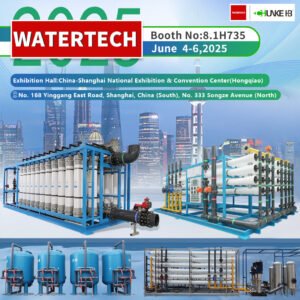Reverse Osmosis & Water Treatment in Qatar
CHUNKE projects of Reverse Osmosis Water Treatment in Qatar including different types of water treatment systems.

Qatar, local vernacular pronunciation: officially the State of Qatar, is a country in West Asia. It occupies the Qatar Peninsula on the northeastern coast of the Arabian Peninsula in the Middle East, accordingly. Hence, it shares its sole land border with Saudi Arabia to the south, with the rest of its territory surrounded by the Persian Gulf. The Gulf of Bahrain, an inlet of the Persian Gulf, separates Qatar from nearby Bahrain. So, the capital is Doha, home to over 80% of the country’s inhabitants, and the land area is mostly made up of flat, low-lying desert.
In early 2017, the total population of Qatar was 2.6 million, with 313,000 of them Qatari citizens and 2.3 million expatriates. Its official religion is Islam. In terms of income, the country has the fourth-highest GDP (PPP) per capita in the world, and the eleventh highest GNI per capita (Atlas method). Hence, Qatar ranks 42nd in the Human Development Index, the third highest HDI in the Arab world. It is a high-income economy, backed by the world’s third-largest natural gas reserves and oil reserves. Qatar is one of the world’s largest exporters of liquefied natural gas, and the world’s largest emitter of carbon dioxide per capita.
Total Renewable Water Resources per Capita in Qatar
In 2020, internal renewable water resources per capita for Qatar was 19.4 cubic meters. Internal renewable water resources per capita of Qatar fell gradually from 469 cubic meters in 1971 to 19.4 cubic meters in 2020.
- Precipitation: 74 mm
- Precipitation volume: 0.9 billion cubic meters
- Rainfall index: 36 mm
- Volume of groundwater produced: 0.1 billion cubic meters
- Renewable water resources per capita: 20.1 cubic meters
- Dependency ratio: 3.4 %
- Freshwater withdrawals: 0.3 billion cubic meters
- Water productivity: 645.7 US dollars per cubic meter
Meanwhile, CHUNKE provides wide range of filtration and economical solutions based on the Qatar’s water resources. So, our water treatment in Qatar becomes more popular accordingly.
- Surface water is water from river, lake which can be treated using different methods, such as Ultrafiltration Systems, Brackish Water RO accordingly.
- Desalination can be used for water from ocean, or sea source, which can be treated using Sea Water Reverse Osmosis Systems; Desalination Systems
- Ground Water or brackish water is from water located in the pore space of soil and rock “Borehole well”, which can be treated using Reverse Osmosis Systems, Borehole Water Filtration Systems, Well Water Filtration Systems, Chemical Dosing, UV Water Sterilizer accordingly.
- Government water supply, which could have high level of hardness or high level of chlorine, can be treated with Water Softener System, Media Water Filters.
CHUNKE Projects of Water Treatment in Qatar
Meanwhile, CHUNKE designs and produces water treatment systems that meet the World Health Organization requirements. So, our water treatment in Qatar is suitable for drinking.
CHUNKE has over 15 years of experience as a global provider of B2B water treatment solutions for a variety of applications and industries. Hence, we offer a large selection of all types of reverse osmosis, ultrafiltration, electrodeionization. And also, water treatment systems to meet your industrial needs accordingly. So, CHUNKE’s extensive global experience in engineering. And manufacturing allows us to pre-engineer and customize water treatment and reverse osmosis systems to meet a wide range of customer requirements and specifications.
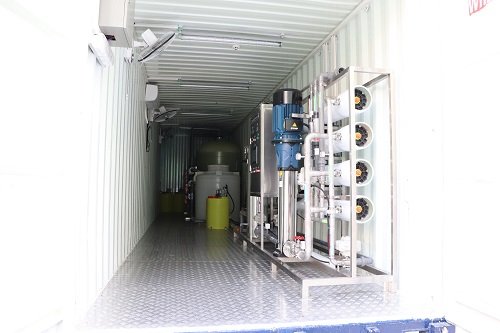
7TPH Containerized Reverse Osmosis BWRO for Farm
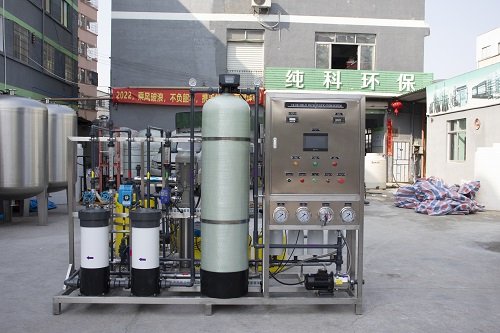
500LPH RO Sea Water Desalination for Irrigation
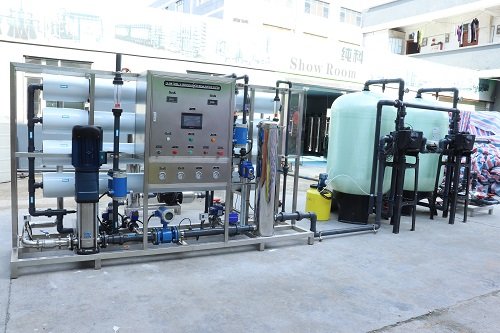
10TPH Salt Water Desalination System for Drinking
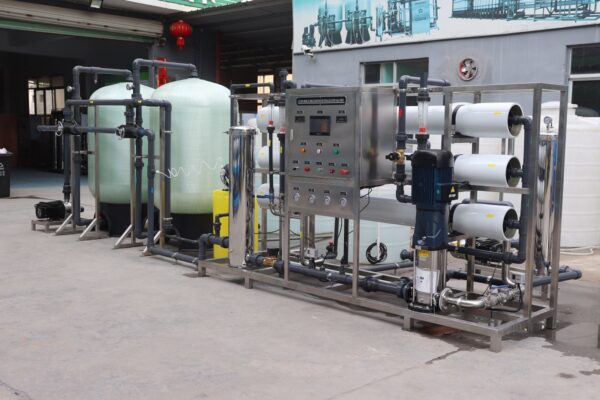
6000LPH Reverse Osmosis System for Drinking
Water scarcity is a significant challenge faced by many countries, and Qatar is no exception. As a nation with limited freshwater resources, Qatar heavily relies on large-scale desalination facilities to meet its growing water demand, accordingly. In this comprehensive guide, we will explore the various aspects of water treatment in Qatar, including the use of reverse osmosis systems, seawater desalination plants, and other purification methods. Join us as we delve into the key factors, challenges, and solutions related to water treatment in Qatar.
Water Resources in Qatar
Qatar’s total renewable water resources are quite limited, with only 0.1 cubic kilometers available. So, the country’s freshwater withdrawal is approximately 0.29 cubic kilometers per year, with domestic, industrial, and agricultural sectors accounting for 24%, 3%, and 72% respectively. Hence, it is important to note that Qatar has practically no permanent surface water. Hence, it is with annual surface runoff estimated at 1.35 million cubic meters. Instead, the main natural internal water resources come from indirect recharge of groundwater through runoff from surrounding catchments and ponding of water in depressions.
Qatar’s groundwater is divided into two distinct regions: the northern half, where a freshwater lens floats on brackish and saline water. And the southern half, where water quality is generally brackish with a thin layer of freshwater at the top. So, the two main aquifers in Qatar, the Alat and Umm er Radhuma, are recharged in Saudi Arabia. The estimated safe yield for the entire country is 45 million cubic meters per year, accordingly.
Desalination in Qatar
Desalination plays a crucial role in meeting Qatar’s water demand. So, the country has invested in major reverse osmosis desalination projects, shifting from thermal technology to membrane-based processes due to environmental factors and energy efficiency. One notable project is the Ras Abu Fontas plant. Which provides 36 MIGD (million imperial gallons per day) of desalinated water to approximately 1 million people. Another significant project is the Umm Al Houl plant, with a capacity to produce 284,000 cubic meters of water per day, expanding to 614,000 cubic meters after the start-up of a new facility, accordingly.
The implementation of reverse osmosis technology on a large scale in Qatar has been a milestone. Considering the complex nature of Qatari waters, characterized by high salinity and levels of colloids and organic matter. Hence, to ensure efficient operation and maintenance of the reverse osmosis plants, challenges such as turbidity issues, membrane fouling, and pretreatment need to be addressed systematically.
Other Water Treatment Methods
While reverse osmosis is a vital component of water treatment in Qatar, it is not the only method used. So, the country also employs other techniques to ensure the availability of clean and safe water. Some of these methods include:
1. Ultrafiltration Systems
Ultrafiltration systems are used to treat surface water, such as river or lake water. So, this method involves passing water through a membrane with fine pores, removing suspended solids, bacteria, and viruses. Hence, ultrafiltration systems are an effective means of improving water quality before further treatment.
2. Seawater Reverse Osmosis Systems
Seawater reverse osmosis (SWRO) systems are specifically designed to treat water from the ocean. So, this method utilizes reverse osmosis membranes to remove salt and other impurities from seawater, producing fresh water suitable for consumption and various industrial applications.
3. Brackish Water Reverse Osmosis Systems
Brackish water reverse osmosis (BWRO) systems are used to treat water with lower salinity levels than seawater but higher than freshwater. These systems are commonly employed in areas where brackish water is the primary water source. Such as Qatar’s groundwater regions. So, BWRO systems effectively remove salts, minerals, and other contaminants, ensuring the production of clean and safe water.
4. Chemical Dosing
Chemical dosing is a common method used in water treatment to enhance the removal of impurities. So, various chemicals, such as coagulants and flocculants, are added to water to facilitate the aggregation of suspended particles, making it easier to remove them through sedimentation or filtration.
5. UV Water Sterilizers
UV water sterilizers utilize ultraviolet light to disinfect water by inactivating microorganisms, including bacteria, viruses, and parasites. So, this method is highly effective in eliminating harmful pathogens and ensuring the safety of drinking water.
6. Water Softener Systems
Water softener systems are used to treat water with high levels of hardness caused by minerals like calcium and magnesium. So, these systems employ ion exchange resins to remove the hardness ions, preventing scale buildup and improving the overall quality of water.
7. Media Water Filters
Media water filters are designed to remove suspended solids, sediments, and other impurities from water. So, these filters use different types of media, such as sand, gravel, and activated carbon, to trap and retain particles, ensuring cleaner and clearer water.
Water Treatment Solutions in Qatar
To address the diverse water treatment needs in Qatar, several companies offer a wide range of solutions and products. One such company is CHUNKE, a global provider of cost-effective water treatment systems for industrial, commercial, and domestic applications. CHUNKE’s extensive experience in engineering and manufacturing allows them to customize and pre-engineer water treatment and reverse osmosis systems to meet specific requirements and specifications, accordingly.
CHUNKE’s water treatment solutions in Qatar include reverse osmosis systems, chemical dosing systems, UV water sterilizers, and water softener systems. So, these solutions are designed to provide high-quality, safe, and sustainable water for various purposes, from industrial processes to drinking water supply.
Conclusion
Water treatment in Qatar is a critical aspect of ensuring the availability of clean and safe water for the country’s growing population and infrastructure development. So, the utilization of reverse osmosis systems, seawater desalination plants, and other purification methods plays a vital role in meeting Qatar’s water demand. By addressing challenges such as membrane fouling, pretreatment, and turbidity issues, Qatar can ensure the efficient operation and maintenance of its water treatment facilities, accordingly. With the expertise and solutions offered by companies like CHUNKE, Qatar can continue to enhance its water treatment capabilities and achieve sustainable water management.
Chunke Water Treatment‘s expertise in producing high-quality reverse osmosis systems has contributed to improving water treatment capabilities in Qatar. So, their reliable and efficient RO plants have been implemented in various projects across the country, ensuring access to clean and safe drinking water.

